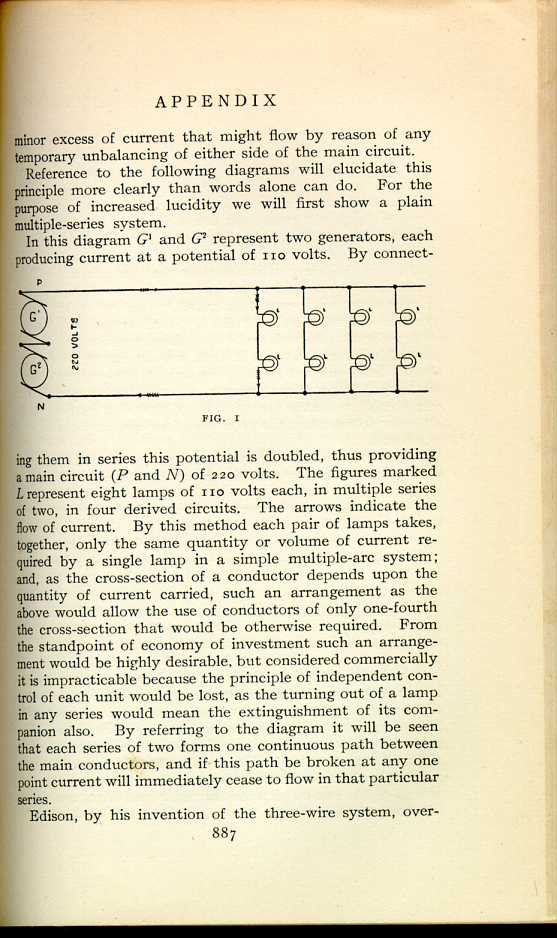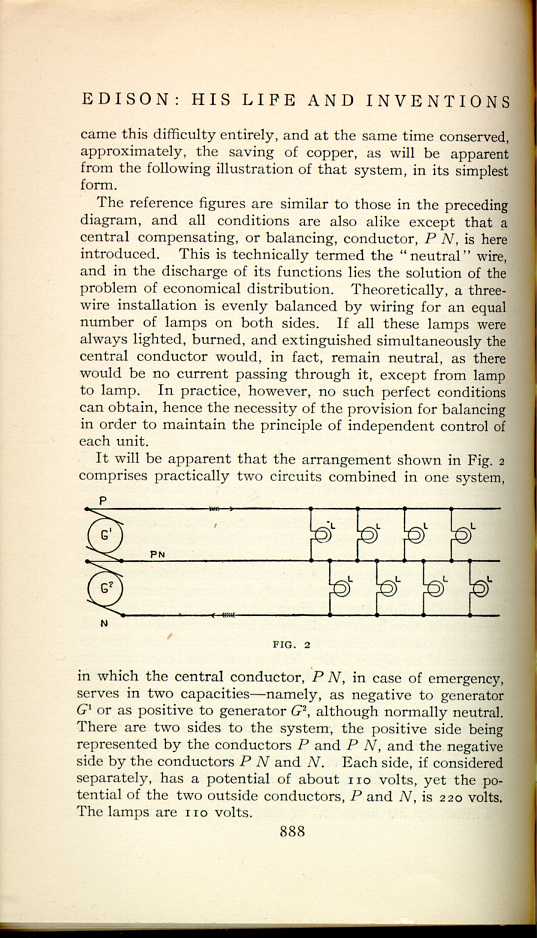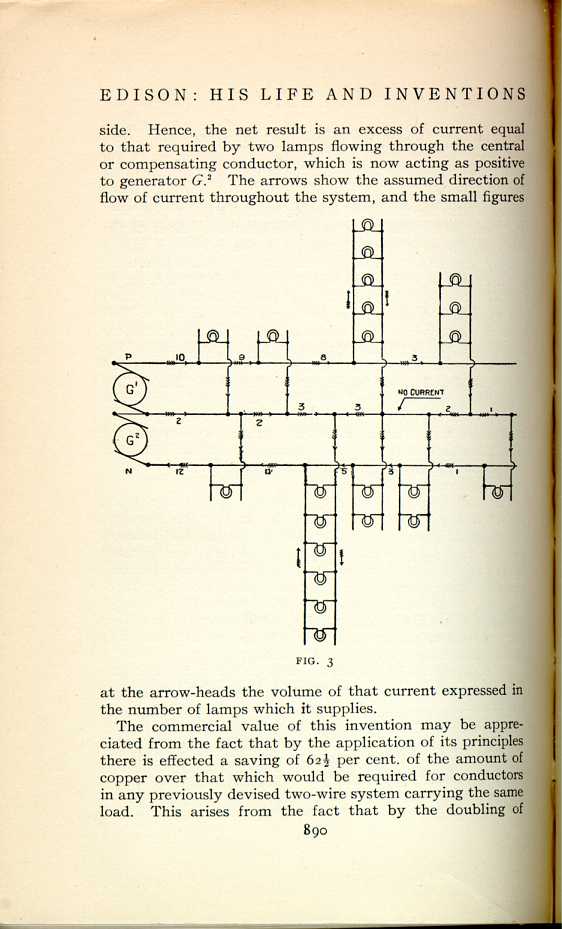|
XII
THE THREE-WIRE SYSTEM
Edison, His Life and Inventions, vol. 2 | ||
12.
XII
THE THREE-WIRE SYSTEM
THIS invention is covered by United States Patent No. 274,290, issued to Edison on March 20, 1883. The object of the invention was to provide for increased economy in the quantity of copper employed for the main conductors in electric light and power installations of considerable extent at the same time preserving separate and independent control of each lamp, motor, or other translating device, upon any one of the various distribution circuits.
Immediately prior to this invention the highest state of the art of electrical distribution was represented by Edison's feeder system, which has already been described as a straight parallel or multiple-arc system wherein economy of copper was obtained by using separate sets of conductors—minus load—feeding current at standard potential or electrical pressure into the mains at centres of distribution.
It should be borne in mind that the incandescent lamp which was accepted at the time as a standard (and has so remained to the present day) was a lamp of 110 volts or thereabouts. In using the word "standard,'' therefore, it is intended that the same shall apply to lamps of about that voltage, as well as to electrical circuits of the approximate potential to operate them.
Briefly stated, the principle involved in the three-wire system is to provide main circuits of double the standard potential, so as to operate standard lamps, or other translating devices, in multiple series of two to each series; and for the purpose of securing independent, individual control of each unit, to divide each main circuit into any desired number of derived circuits of standard potential (properly balanced) by means of a central compensating conductor which would be normally neutral, but designed to carry any
Reference to the following diagrams will elucidate this principle more clearly than words alone can do. For the purpose of increased lucidity we will first show a plain multiple-series system.
In this diagram G1 and
G2
represent two generators, each
producing current at a potential of 110 volts. By connecting

FIG. 1
[Description: Illustration of two generators connected in a series.]
Edison, by his invention of the three-wire system, overcame
The reference figures are similar to those in the preceding diagram, and all conditions are also alike except that a central compensating, or balancing, conductor, PN, is here introduced. This is technically termed the "neutral'' wire, and in the discharge of its functions lies the solution of the problem of economical distribution. Theoretically, a three-wire installation is evenly balanced by wiring for an equal number of lamps on both sides. If all these lamps were always lighted, burned, and extinguished simultaneously the central conductor would, in fact, remain neutral, as there would be no current passing through it, except from lamp to lamp. In practice, however, no such perfect conditions can obtain, hence the necessity of the provision for balancing in order to maintain the principle of independent control of each unit.
It will be apparent that the arrangement shown in Fig. 2
comprises practically two circuits combined in one system,

FIG. 2
[Description: Illustration of two circuits combined in one system.]
In practical use the operation of the system is as follows: If all the lamps were lighted the current would flow along P and through each pair of lamps to N, and so back to the source of energy. In this case the balance is preserved and the central wire remains neutral, as no return current flows through it to the source of energy. But let us suppose that one lamp on the positive side is extinguished. None of the other lamps is affected thereby, but the system is immediately thrown out of balance, and on the positive side there is an excess of current to this extent which flows along or through the central conductor and returns to the generator, the central conductor thus becoming the negative of that side of the system for the time being. If the lamp extinguished had been one of those on the negative side of the system results of a similar nature would obtain, except that the central conductor would for the time being become the positive of that side, and the excess of current would flow through the negative, N, back to the source of energy. Thus it will be seen that a three-wire system, considered as a whole, is elastic in that it may operate as one when in balance and as two when unbalanced, but in either event giving independent control of each unit.
For simplicity of illustration a limited number of circuits, shown in Fig. 2, has been employed. In practice, however, where great numbers of lamps are in use (as, for instance, in New York City, where about 7,000,000 lamps are operated from various central stations), there is constantly occurring more or less change in the balance of many circuits extending over considerable distances, but of course there is a net result which is always on one side of the system or the other for the time being, and this is met by proper adjustment at the appropriate generator in the station.
In order to make the explanation complete, there is presented another diagram showing a three-wire system unbalanced:
The reference figures are used as before, but in this case the vertical lines represent branches taken from the main conductors into buildings or other spaces to be lighted, and the loops between these branch wires represent lamps in operation. It will be seen from this sketch that there are ten lamps on the positive side and twelve on the negative

FIG. 3
[Description: Illustration of three wire system.]The commercial value of this invention may be appreciated from the fact that by the application of its principles there is effected a saving of 62 ½ per cent. of the amount of copper over that which would be required for conductors in any previously devised two-wire system carrying the same load. This arises from the fact that by the doubling of
The three-wire system is in universal use throughout the world at the present day.
|
XII
THE THREE-WIRE SYSTEM
Edison, His Life and Inventions, vol. 2 | ||